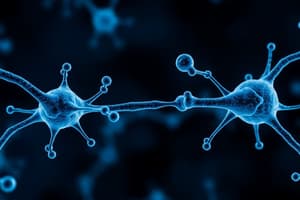Podcast
Questions and Answers
What is the primary aim of target identification in drug development?
What is the primary aim of target identification in drug development?
- To locate targets related to a disease that can be effectively targeted by drugs. (correct)
- To determine the price of a drug.
- To create genetic markers for diseases.
- To analyze the marketing strategy of a new drug.
Which of the following methods is NOT typically part of the target identification process?
Which of the following methods is NOT typically part of the target identification process?
- Genomics
- Transcriptomics
- Psychographics (correct)
- Metabolomics
What is one key limitation of genome-wide association studies (GWAS)?
What is one key limitation of genome-wide association studies (GWAS)?
- They can only study diseases caused by a single gene.
- They struggle with identifying rare variants. (correct)
- They require a sample size of less than 100 individuals.
- They only focus on environmental factors.
What is the main focus of variant effect prediction?
What is the main focus of variant effect prediction?
Genome-wide association studies (GWAS) are particularly useful for identifying what?
Genome-wide association studies (GWAS) are particularly useful for identifying what?
Which components combine laboratory and in silico technologies for drug target identification?
Which components combine laboratory and in silico technologies for drug target identification?
What is the primary focus of the study of transcriptomics?
What is the primary focus of the study of transcriptomics?
Which technique provides a high-resolution view of gene expression in individual cells?
Which technique provides a high-resolution view of gene expression in individual cells?
Which statement about bulk RNA sequencing is true?
Which statement about bulk RNA sequencing is true?
What are the limitations of endophenotypes in clinical studies?
What are the limitations of endophenotypes in clinical studies?
Which technique is correctly matched with its primary purpose?
Which technique is correctly matched with its primary purpose?
What defines an undruggable protein?
What defines an undruggable protein?
Which approach uses known variant effects to evaluate the likelihood of a variant being pathogenic?
Which approach uses known variant effects to evaluate the likelihood of a variant being pathogenic?
What does single-cell RNA sequencing allow researchers to explore?
What does single-cell RNA sequencing allow researchers to explore?
In structure-based drug design, why is protein 3D structure important?
In structure-based drug design, why is protein 3D structure important?
What are the four levels of protein structure, in order from simplest to most complex?
What are the four levels of protein structure, in order from simplest to most complex?
Which method provides high-resolution structures and analyzes proteins in their natural state?
Which method provides high-resolution structures and analyzes proteins in their natural state?
What is a challenge associated with X-ray crystallography?
What is a challenge associated with X-ray crystallography?
How do protein language models, such as ESM1b, evaluate the impact of genetic variants?
How do protein language models, such as ESM1b, evaluate the impact of genetic variants?
What does spatial transcriptomics measure that bulk and single-cell RNA sequencing do not?
What does spatial transcriptomics measure that bulk and single-cell RNA sequencing do not?
What is a primary disadvantage of cryo-electron microscopy compared to X-ray crystallography?
What is a primary disadvantage of cryo-electron microscopy compared to X-ray crystallography?
Which modeling method is least reliant on previously known protein structures?
Which modeling method is least reliant on previously known protein structures?
Which feature differentiates homology modeling from ab initio prediction?
Which feature differentiates homology modeling from ab initio prediction?
What significant achievement is associated with AlphaFold2?
What significant achievement is associated with AlphaFold2?
What crucial role does understanding protein structure play in drug discovery?
What crucial role does understanding protein structure play in drug discovery?
What database provides access to over 200 million predicted protein structures?
What database provides access to over 200 million predicted protein structures?
Which of the following best describes alphaFold2's impact on protein structure prediction?
Which of the following best describes alphaFold2's impact on protein structure prediction?
What is the main limitation of ab initio modeling for protein structure prediction?
What is the main limitation of ab initio modeling for protein structure prediction?
In protein structure prediction, what does the term 'RMSD' refer to?
In protein structure prediction, what does the term 'RMSD' refer to?
Why is computational prediction of protein structures increasingly important?
Why is computational prediction of protein structures increasingly important?
Flashcards
Target Identification
Target Identification
Finding potential drug targets related to a disease that can be treated with drugs.
Omic Methods
Omic Methods
Multi-layered methods to study biological processes at the molecular level. They provide a complete view of biology.
Genomics
Genomics
Study of the entire genome — all the DNA in an organism. It looks at how genes work together.
Genome-Wide Association Studies (GWAS)
Genome-Wide Association Studies (GWAS)
Signup and view all the flashcards
Variant Effect Prediction
Variant Effect Prediction
Signup and view all the flashcards
Druggable Target
Druggable Target
Signup and view all the flashcards
Transcriptomics
Transcriptomics
Signup and view all the flashcards
Single-cell RNA sequencing
Single-cell RNA sequencing
Signup and view all the flashcards
Proteomics
Proteomics
Signup and view all the flashcards
Protein 3D Structure
Protein 3D Structure
Signup and view all the flashcards
X-ray Crystallography
X-ray Crystallography
Signup and view all the flashcards
Protein Data Bank (PDB)
Protein Data Bank (PDB)
Signup and view all the flashcards
Metabolomics
Metabolomics
Signup and view all the flashcards
Bulk RNA Sequencing (RNAseq)
Bulk RNA Sequencing (RNAseq)
Signup and view all the flashcards
Single Cell RNA Sequencing (scRNAseq)
Single Cell RNA Sequencing (scRNAseq)
Signup and view all the flashcards
Spatial Transcriptomics
Spatial Transcriptomics
Signup and view all the flashcards
GWAS (Genome-Wide Association Study)
GWAS (Genome-Wide Association Study)
Signup and view all the flashcards
Endophenotype
Endophenotype
Signup and view all the flashcards
Cryo-EM
Cryo-EM
Signup and view all the flashcards
Homology Modeling
Homology Modeling
Signup and view all the flashcards
Protein Threading
Protein Threading
Signup and view all the flashcards
Ab initio Modeling
Ab initio Modeling
Signup and view all the flashcards
AlphaFold2
AlphaFold2
Signup and view all the flashcards
Ligand Binding Site
Ligand Binding Site
Signup and view all the flashcards
Binding Affinity
Binding Affinity
Signup and view all the flashcards
Protein Structure Prediction
Protein Structure Prediction
Signup and view all the flashcards
Study Notes
Drug Target Identification
- Drug target identification finds disease-related, druggable targets (proteins & nucleotides).
- Key technologies include genomics, transcriptomics, proteomics, metabolomics, and 3D structures.
- Target identification combines in silico (computer-based) and laboratory techniques.
Omic-Based Methods
-
Omic methods offer a multi-layered understanding of molecular biology.
-
Genomics*
-
Genome-wide association studies (GWAS):
- Examine genomes to link genetic markers to diseases.
- Steps include data collection, genotyping, quality control, analysis, and validation.
- Helps identify risk factors for diseases like diabetes and cancer.
- Challenges include handling rare variants and multifaceted traits.
-
Variant Effect Prediction:
- Predicts disease impacts of genetic variants, valuable for rare/novel changes.
- 2 AI approaches:
- Using known variant effects (e.g., PrimateAI, leveraging evolutionary conservation, and protein structure prediction).
- Inferring effects from protein evolutionary landscape (e.g., protein language models, using patterns in protein sequences and log-likelihood ratios).
-
Transcriptomics*
-
RNA sequencing (RNA-Seq):
- Bulk RNA-Seq: Analyzes gene expression in a cell mixture, comparing, for example, pre and post-drug treatment.
- Single-cell RNA-Seq (scRNA-Seq): Profiles individual cell gene expression, allowing for identifying cell types (heterogeneity).
- Spatial transcriptomics: Measures gene expression in tissues preserving spatial information, aiding in cell-cell interactions.
-
Proteomics*
-
Large-scale study of proteins (proteome) expressed in specific conditions.
-
Metabolomics*
-
Study of metabolites (small molecules) in cellular metabolism.
-
Integration of Omic Approaches:*
-
Combining multiple omic methods creates a more comprehensive view of complex disease processes.
Molecular Structures in Drug Discovery
- Protein 3D structures are vital for drug design.
- Structure-based drug design uses 3D structures to design drug molecules that bind specifically to targets.
- Challenges of Targeting Proteins:*
- Some proteins lack discernible binding sites for ligands, making them difficult to target with drugs.
- Determining whether a protein is a viable drug target.
Protein Structures
-
Levels of protein structure:
- Primary: Amino acid sequence
- Secondary: Local motifs (alpha helices, beta sheets)
- Tertiary: Overall 3D structure of one protein chain
- Quaternary: Interactions of multiple subunits forming a complex.
-
Protein Data Bank (PDB): Global repository of protein, nucleic acid, and complex structures.
Structure Determination Methods
- 3 Main techniques:
- X-ray crystallography: High resolution, widely used, but challenging crystal preparation, & static view.
- NMR spectroscopy: High resolution, studies proteins in solution (natural state), challenging sample prep, and small proteins.
- Cryo-EM: Easy sample prep, studies proteins in their native state, small sample size, good for large complexes but lower resolution, expensive equipment
Protein Structure Prediction
-
Need for prediction: Experimental structure determination is time-consuming and expensive.
-
Prediction methods (2 main categories):
- Template-based modeling:
- Homology modeling: Leverages high sequence similarity.
- Protein threading: Low sequence similarity – aligns sequence to existing structures.
- Ab initio modeling: Predicts structure from sequence alone without comparing to known structures, but less accurate.
- Template-based modeling:
AlphaFold2
- AI system for groundbreaking accuracy in protein structure prediction, developed by Google DeepMind.
- Input: Protein sequence
- Output: Detailed 3D structure (atoms, backbone, side chains)
- Uses multiple sequence alignments, and neural networks.
- High accuracy (e.g. high TM-scores and GDT-scores), rivals experimental structures.
- Revolutionizes drug discovery, structural biology, and molecular biology.
Resources for Protein Structure Prediction
- Databases (AlphaFold Protein Structure Database, ESM Metagenomic Atlas)
- Online tools (ColabFold, ESM Fold Sequence)
Transition to Drug Screening and Design
- Understanding protein structure is crucial for structure-based drug discovery leading to hit identification and lead optimization.
Studying That Suits You
Use AI to generate personalized quizzes and flashcards to suit your learning preferences.




